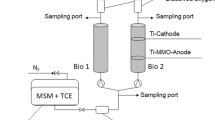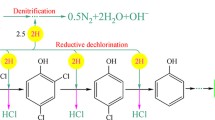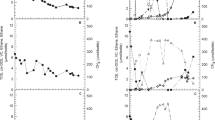Abstract
This study investigates how the feeding pattern of e− donors might affect the efficiency of enhanced in situ bioremediation in TCE-contaminated aquifers. A series of lab-scale batch experiments were conducted using butyrate or hydrogen gas (H2) as e− donor and a TCE-dechlorinating microbial consortium dominated by Dehalococcoides spp. The results of these experiments demonstrate that butyrate is similarly efficient for TCE dechlorination whether it is injected once or in doses. Moreover, the present work indicates that the addition of butyrate in great excess cannot be avoided, since it most likely provide, even indirectly, significant part of the H2 required. Furthermore, methanogenesis appears to be the major ultimate e− accepting process in all experiments, regardless the e− donor used and the feeding pattern. Finally, the timing of injection of H2 seems to significantly affect dechlorination performance, since the injection during the early stages improves VC-to-ETH dechlorination and reduce methanogenic activity.




Similar content being viewed by others
References
Aulenta F, Majone M, Tandoi V (2006) Review: enhanced anaerobic bioremediation of chlorinated solvents: environmental factors influencing microbial activity and their relevance under field conditions. J Chem Technol Biotechnol 81:1463–1474
Cord-Ruwisch R, Lovley DR, Schink B (1998) Growth of Geobacter sulfurreducens with acetate in syntrophic cooperation with hydrogen-oxidizing anaerobic partners. Appl Environ Microb 64:2232–2236
Fennell DE, Gossett JM (2003) Microcosms for site-specific evaluation of enhanced biological reductive dehalogenation. In: Häggblom MM, Bossert ID (eds) Dehalogenation, microbial processes and environmental applications. Kluwer Academic Publishers, Dordrecht, pp 385–420
Hattori S (2008) Mini review, syntrophic acetate-oxidizing in methanogenic environments. Microbes Environ 23:118–127
Heimann AC, Friis AK, Jakobsen R (2005) Effects of sulfate on anaerobic chloroethene degradation by an enriched culture under transient and steady-state hydrogen supply. Water Res 39:3579–3586
Henry BM (2010) Biostimulation for anaerobic bioremediation of chlorinated solvents. In: Stroo HF, Ward CH (eds) In situ remediation of chlorinated solvent plumes. Springer, New York, pp 357–423
Moran MJ, Zogorski JS, Squillace PJ (2007) Chlorinated solvents in groundwater of the United States. Environ Sci Technol 41:74–81
Panagiotakis I, Mamais D, Pantazidou M, Marneri M, Parapouli M, Hatziloukas E, Tandoi V (2007) Dechlorinating ability of TCE-fed microcosms with different electron donor. J Hazard Mater 149:582–589
Panagiotakis I, Mamais D, Pantazidou M, Rossetti S, Aulenta F, Tandoi V (2014) Predominance of Dehalococcoides in the presence of different sulfate concentrations. Water Air Soil Pollut 225:1785
Smatlak CR, Gossett JM, Zinder SH (1996) Comparison kinetics of hydrogen utilization for reductive dechlorination of tetrachloroethene and methanogenesis in an anaerobic enrichment culture. Environ Sci Technol 30:2850–2858
USΕPA (2006) In situ and ex situ biodegradation technologies for remediation of contaminated sites, EPA/625/R-6/015. http://www.epa.gov/nrmrl/pubs/625r06015/625r06015.pdf
Yang Y, McCarty PL (1998) Competition for hydrogen within a chlorinated solvent dechlorinating anaerobic mixed culture. Environ Sci Technol 32:3591–3597
Yang Y, McCarty PL (2000) Biomass, oleate, and other possible substrates for chloroethene reductive dehalogenation. Bioremediat J 4:125–133
Acknowledgments
This research was partially supported by a 4-year scholarship granted to Iraklis Panagiotakis and Kornilia Antoniou by the Department of Water Resources and Environmental Engineering of the School of Civil Engineering of the National Technical University of Athens.
Author information
Authors and Affiliations
Corresponding author
Rights and permissions
About this article
Cite this article
Panagiotakis, I., Antoniou, K., Mamais, D. et al. Effects of Different Electron Donor Feeding Patterns on TCE Reductive Dechlorination Performance. Bull Environ Contam Toxicol 94, 289–294 (2015). https://doi.org/10.1007/s00128-015-1462-3
Received:
Accepted:
Published:
Issue Date:
DOI: https://doi.org/10.1007/s00128-015-1462-3




